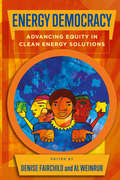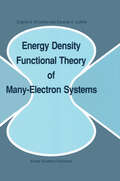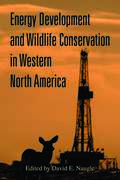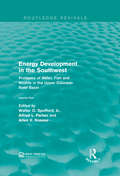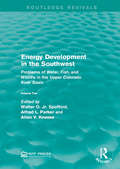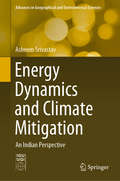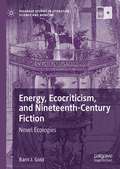- Table View
- List View
Energy Demand Challenges in Europe: Implications for policy, planning and practice
by Frances Fahy Gary Goggins Charlotte JensenThis open access book examines the role of citizens in sustainable energy transitions across Europe. It explores energy problem framing, policy approaches and practical responses to the challenge of securing clean, affordable and sustainable energy for all citizens, focusing on households as the main unit of analysis. The book revolves around ten contributions that each summarise national trends, socio-material characteristics, and policy responses to contemporary energy issues affecting householders in different countries, and provides good practice examples for designing and implementing sustainable energy initiatives. Prominent concerns include reducing carbon emissions, energy poverty, sustainable consumption, governance, practices, innovations and sustainable lifestyles. The opening and closing contributions consider European level energy policy, dominant and alternative problem framings and similarities and differences between European countries in relation to reducing household energy use. Overall, the book is a valuable resource for researchers, policy-makers, practitioners and others interested in sustainable energy perspectives.
Energy Democracy: Advancing Equity in Clean Energy Solutions
by Denise Fairchild and Al WeinrubThis volume brings together racial, cultural, and generational perspectives. This diversity is bound together by a common operating frame: that the global fight to save the planet—to conserve and restore our natural resources to be life-sustaining—must fully engage community residents and must change the larger economy to be sustainable, democratic, and just. The contributors offer their perspectives and approaches to climate and clean energy from rural Mississippi, to the South Bronx, to Californian immigrant and refugee communities, to urban and semi-rural communities in the Northeast. Taken together, the contributions in this book show what an alternative, democratized energy future can look like, and will inspire others to take up the struggle to build the energy democracy movement.
Energy Democracy: Germany’s Energiewende to Renewables
by Craig Morris Arne JungjohannThis book outlines how Germans convinced their politicians to pass laws allowing citizens to make their own energy, even when it hurt utility companies to do so. It traces the origins of the Energiewende movement in Germany from the Power Rebels of Schönau to German Chancellor Angela Merkel’s shutdown of eight nuclear power plants following the 2011 Fukushima nuclear accident. The authors explore how, by taking ownership of energy efficiency at a local level, community groups are key actors in the bottom-up fight against climate change. Individually, citizens might install solar panels on their roofs, but citizen groups can do much more: community wind farms, local heat supply, walkable cities and more. This book offers evidence that the transition to renewables is a one-time opportunity to strengthen communities and democratize the energy sector – in Germany and around the world.
Energy Density Functional Theory of Many-Electron Systems (Understanding Chemical Reactivity #4)
by Eugene S. Kryachko Eduardo V. LudeñaEnergy Development and Wildlife Conservation in Western North America
by David E. NaugleEnergy Development and Wildlife Conservation in Western North America offers a road map for securing our energy future while safeguarding our wildlife heritage. Contributors show how science can help craft solutions to conflicts between wildlife and energy development by delineating core areas, identifying landscapes that support viable populations, and forecasting future development scenarios to aid in conservation design.The book calls for a shift away from site-level management that has failed to mitigate cumulative impacts on wildlife populations toward broad-scale planning and implementation of conservation in priority landscapes. It concludes by identifying ways that decision makers can remove roadblocks to conservation, and provides a blueprint for implementing conservation plans.
Energy Development in the Southwest: Problems of Water, Fish and Wildlife in the Upper Colorado River Basin (Routledge Revivals)
by Walter O. Spofford Alfred L. Parker Allen V. KneeseFirst published in 1980, the first volume of Energy Development in the Southwest analyses four potential energy development scenarios for the Four Corner states (i.e., Arizona, Colorado, New Mexico, Utah, and Wyoming) and for the Upper Colorado River Basin, based on alternative national energy scenarios and attempts to assess some of the economic, demographic, and environmental impacts of each development scenario. The energy development scenarios considered in this book involve coal development and use, oil share production, and uranium mining and milling. This title will be of particular interest to students of Environmental Science.
Energy Development in the Southwest: Problems of Water, Fish and Wildlife in the Upper Colorado River Basin (Routledge Revivals)
by Walter O. Spofford Alfred L. Parker Allen V. KneeseFirst published in 1980, the first volume of Energy Development in the Southwest analyses four potential energy development scenarios for the Four Corner states (i.e., Arizona, Colorado, New Mexico, Utah, and Wyoming) and for the Upper Colorado River Basin, based on alternative national energy scenarios and attempts to assess some of the economic, demographic, and environmental impacts of each development scenario. The energy development scenarios considered in this book involve coal development and use, oil share production, and uranium mining and milling. This title will be of particular interest to students of Environmental Science.
Energy Development in the Southwest: Problems of Water, Fish, and Wildlife in the Upper Colorado River Basin (Routledge Revivals)
by Walter O. Spofford Alfred L. Parker Allen V. KneeseFirst published in 1980, the second volume of Energy Development in the Southwest analyses water conditions and habitat life in the Upper Colorado River Basin, based on alternative national energy scenarios and attempts to assess some of the economic, demographic, and environmental impacts of each development scenario. The energy development scenarios considered in this book involve coal development and use, oil share production, and uranium mining and milling. This title will be of particular interest to students of Environmental Science.
Energy Development in the Southwest: Problems of Water, Fish, and Wildlife in the Upper Colorado River Basin (Routledge Revivals)
by Walter O. Spofford Alfred L. Parker Allen V. KneeseFirst published in 1980, the second volume of Energy Development in the Southwest analyses water conditions and habitat life in the Upper Colorado River Basin, based on alternative national energy scenarios and attempts to assess some of the economic, demographic, and environmental impacts of each development scenario. The energy development scenarios considered in this book involve coal development and use, oil share production, and uranium mining and milling. This title will be of particular interest to students of Environmental Science.
Energy Dissipation in Composite Materials
by Peter A. Zinoviev Yury N. ErmakovAll real materials in one way or another, exhibit a departure from ideal elastic behaviour, even at very small strain values. Under cyclic deformation, these departtures result in irreversible energy losses in material. The causes of such losses are many, and include the irreversible transfer of mechanical energy into heat, growth of cracks and other defects, and the microplastic deformaton of crystals to name a few. Several terms have been suggested to define these phenomena including damping, energy dissipation, imperfect elasticity and internal friction. This book is about materials damping; with damping or energy dissipation processes in vibrating solids.
Energy Dissipation in Composite Materials
by Peter A. Zinoviev Yury N. ErmakovAll real materials in one way or another, exhibit a departure from ideal elastic behaviour, even at very small strain values. Under cyclic deformation, these departtures result in irreversible energy losses in material. The causes of such losses are many, and include the irreversible transfer of mechanical energy into heat, growth of cracks and other defects, and the microplastic deformaton of crystals to name a few. Several terms have been suggested to define these phenomena including damping, energy dissipation, imperfect elasticity and internal friction. This book is about materials damping; with damping or energy dissipation processes in vibrating solids.
Energy Dissipation in Molecular Systems
by André Tramer Christian Jungen Françoise LahmaniEnergy Dissipation in Molecular Systems analyzes experimental data on the redistribution and dissipation of energy injected into molecular systems by radiation or charged particles. These processes, competing with such practically important relaxation channels as chemical reaction or stimulated emission (laser action), are the primary focus in this monograph. Among other topics, the book treats vibrational redistribution and electronic relaxation in isolated molecules and the effects of inter-molecular interactions (collisions, complex formation, solvent effects) on the relaxation paths. Primary photo-chemical processes (such as isomerization, proton or hydrogen-atom transfer, electron transfer and ionization) are also treated as particular cases of vibrational or electronic relaxation. Only a basic knowledge of quantum mechanics and spectroscopy is assumed and calculations are kept to a strict minimum, making the book more accessible to students.
Energy Dissipators and Hydraulic Jump (Water Science and Technology Library #8)
by Willi H. HagerStilling basins utili z ing a hydraulic jump for energy dissipation are w i d e l y used in hydraulic engineering . D a Vinci was the first to describe the hydraulic jump, and Bidone conducted classical experiments about 170 years ago . Stilling basins w e r e developed in the thirties with signif- cant design improvements being made during the last sixty years . Although w e l l - a c c e p t e d guidelines for a successful design are presently available, the information for the design of such dissipators is not yet compiled in book form . This book provides state-of-the-art information on hydraulic jumps and associat ed stilling basins . A large numbe r of papers on the to pics are reviewed. T h e present trends of the art of designing a stilli ng basin are discussed and ideas for future research are outlined. Design criteria and recommendat ions are frequently given . However, this should not be considered as a r eady-to -use guideline since the design of an effective stilling basin is much more comple x than following general design steps . The book is divided into two parts. Part 1 on hydraulic jumps is c- prised of chapters 2 to 5. Part 2 consisting of chapters 6 to 14 deals with various hydraulic structures used to dissipate energy. The lists of notation and references are provided in each part separately although the same notation is u sed throughout.
Energy Dynamics and Climate Mitigation: An Indian Perspective (Advances in Geographical and Environmental Sciences)
by Asheem SrivastavThis book analyzes the current approaches to energy management in India that is based on a carbon-intensive pathway, which if continued, may have serious implications for climate change mitigation with severe consequences for human health and survival. India, being a signatory to the United Nations Framework Convention on Climate Change (UNFCCC), the Kyoto Protocol, and the Paris Agreement, is committed to reducing greenhouse gas emissions; however, the country’s dilemmas are whether to prioritize environment over economy or vice versa and also whether economic growth can be sustained by relying on carbon-intensive development. Those are explored in this book. The Indian economy is poised for a big leap in the near future, and the topmost priority of the government is to ensure energy security, accessibility, and affordability for nearly 1.5 billion people. Currently, 70% of India’s electricity generation comes from coal- and oil-based thermal power plants, and only 12–15% of energy is generated from renewable sources. Experts are of the view that the demand for coal and gas power generation will continue to rise and is expected to reach the equivalent of nearly 2 billion t of oil by 2030. The annual consumption of natural gas is expected to increase fourfold to 200 billion m3 a year in the near future, and its share in the primary energy basket of coal, oil, and gas will rise from 6.5% to 15% by 2030. This will not only cause a significant drain on foreign reserves but will also pose an enormous challenge to policymakers and scientists. This book serves as a useful guide in shaping India’s future energy policy.
Energy, Ecocriticism, and Nineteenth-Century Fiction: Novel Ecologies (Palgrave Studies in Literature, Science and Medicine)
by Barri J. GoldEnergy, Ecocriticism, and Nineteenth-Century Fiction: Novel Ecologies draws on energy concepts to revisit some of our favorite books—Mansfield Park, Jane Eyre, Great Expectations, and The War of the Worlds—and the ways these shape our sense of ourselves as ecological beings. Barri J. Gold regards the laws of thermodynamics not solely as a set of physical principles, but also as a cultural and conceptual form that we can use to reimagine our historically vexed relationship to the natural world. Beginning with an examination of the parallel inceptions of energy and ecology in the mid-nineteenth century, this book considers the question of how we may better read and interpret our world, developing a recipe for experimental reading and insisting upon the importance of literary studies in a world driving to ecological catastrophe.
Energy Economics: CO2 Emissions in China
by Yiming Wei Lancui Liu Gang Wu Lele Zou"Energy Economics: CO2 Emissions in China" presents a collection of the researches on China's CO2 emissions as studied by the Center for Energy & Environmental Policy Research (CEEP). Based on the analysis of factors related to global climate change and CO2 emissions, it discusses China's CO2 emissions originating from various sectors, diverse impact factors, as well as proposed policies for reducing carbon emissions. Featuring empirical research and policy analysis on focused and critical issues involving different stages of CO2 emissions in China, the book provides scientific supports for researchers and policy makers in dealing with global climate change.
Energy Ecosystems: Applied Digital Technologies (Lecture Notes in Networks and Systems #626)
by Natalia KostrikovaThis book aims to review the key areas of modern research in power engineering regarding environmental conservation, as well as the research and development of digital technologies in the energy sector.The main result of fruitful work within the framework of the III International Conference "Energy Ecosystems: Prospects and Challenges: Applied Digital Technologies" has become this book, which includes 16 best reports on priority issues of modern energy development.The book is of interest to scientists, students, researchers, representatives of energy companies, representatives of leading Russian and European universities, and research institutes. We feel confident that our book will serve as an important source of information and knowledge that will lead to scientific and innovative progress in the field of sustainable development of the society.
Energy Effectiveness: Strategic Objectives, Energy and Water at the Heart of Enterprise
by Sandra McCardellThis book describes practical ways to understand energy and water use in organizations and then manage or control that use, thereby reducing risk and cost. The author presents a strategic framework to focus on the types of questions that should be addressed internally, Including evaluation of potential projects, planning and implementing energy projects, and evaluating results. The premise is that no modern organization can exist without energy, despite the fact that energy is also one of the mandatory inputs that receives little to no attention in most organizations. This work highlights methodologies and projects that illuminate ways in which energy management is central to an organization’s success, considering in each case the four main determinants of energy use: People, Buildings, Equipment /Processes, and the Environment. The book constitutes a complete energy savings resource for business owners, middle managers, and building and energy managers, providing options, free tools, and flexible project templates.
Energy Efficiency: Real Time Energy Infrastructure Investment and Risk Management
by Leslie A. SolmesENERGY EFFICIENCY uses an applied scientific methodology and case studies to demonstrate and support: The need for the U.S. and the world to commit to energy and resource efficiency as the central goal in investing in electric, heat, and cooling infrastructure, the huge economic opportunity for using the inefficiency built into 20th century energy supply systems, especially, electric, to pay for the upgrades, replacements, and new production and distribution systems of the 21st century, the importance of adopting a standard, web-based energy infrastructure investment decision-making and risk management tool that will serve as a communication medium for all stakeholders to evaluate and compare energy infrastructure investment options and manage investment risks, expansions of the U.S. ‘smart’ grid investment to include evaluation and risk management of energy systems infrastructure investments not just electricity operations, the need to adopt a ‘framework’ for utilities, energy service companies, and customers to work together to close business deals, communicate and manage risks, and realize profits.
Energy Efficiency: Benefits for Environment and Society (Green Energy and Technology)
by Ming Yang Xin YuThis book discusses how energy efficiency benefits the global environment, national energy security, local pollution mitigation, natural resource conservation, and utility bill reduction. In addition, this book provides many hands-on skills and knowledge to identify and develop energy efficiency projects. The literature review shows that energy efficiency has become the first fuel in the world energy supply. With empirical analyses, this book indicates that without continued investment in energy efficiency, neither China nor the U.S. could achieve their carbon emission reduction targets that were announced on November 13, 2014 during the Beijing 2014 APEC meeting. The authors argue that energy efficiency will become the first tool to mitigate climate change. These include (1) identifying energy efficiency barriers, (2) developing energy policies, (3) investing in energy efficient technologies, (4) undertaking project cost-effectiveness analysis, (5) de-risking and financing energy efficiency projects; (6) developing and managing energy service companies, and (7) promoting urban transport efficiency. Two case studies in energy efficiency improvement in electrical motors and industrial boilers are also presented. This book is written for college and university students, practitioners, researchers, consultants, project developers, and policy makers who want to dedicate their professional careers in global energy efficiency improvement, climate change mitigation, local clean air initiatives, and energy bill reduction.
Energy Efficiency and Conservation in Metal Industries: With Selected Cases of Investment Grade Audit
by Swapan Kumar Dutta Jitendra Saxena Binoy Krishna ChoudhuryThis book provides a deep insight into the energy usage in the energy intensive metal industry and the methodology for efficiency assessment. Various methodologies for energy audits are described, along with concept-level analysis for minimum energy design. Apart from the technical and engineering analysis, the book also describes management aspects such as energy management systems and financial, environmental and social analysis leading to the development of a comprehensive plan for implementation of energy efficiency and conservation in industries. Barriers to investment in energy efficiency and conservation are discussed, based on review of global and Indian case studies. FEATURES: Details fundamental principles driving energy consumption in an industrial set-up backed with illustrative examples Explains various alternative methods for discovery of energy efficiency and conservation projects. Focusses on metal-producing and -processing facilities with an emphasis on environmental quality Supports maximum digitalization of energy audit assessment and report preparation processes Includes global case studies and tutorials at the end of the corresponding chapters This book is useful for researchers, professionals and graduate students in thermodynamics, manufacturing, thermal engineering, energy engineering, energy efficiency and energy processes, especially in the metal industry.
Energy Efficiency and Conservation in Metal Industries: With Selected Cases of Investment Grade Audit
by Swapan Kumar Dutta Jitendra Saxena Binoy Krishna ChoudhuryThis book provides a deep insight into the energy usage in the energy intensive metal industry and the methodology for efficiency assessment. Various methodologies for energy audits are described, along with concept-level analysis for minimum energy design. Apart from the technical and engineering analysis, the book also describes management aspects such as energy management systems and financial, environmental and social analysis leading to the development of a comprehensive plan for implementation of energy efficiency and conservation in industries. Barriers to investment in energy efficiency and conservation are discussed, based on review of global and Indian case studies. FEATURES: Details fundamental principles driving energy consumption in an industrial set-up backed with illustrative examples Explains various alternative methods for discovery of energy efficiency and conservation projects. Focusses on metal-producing and -processing facilities with an emphasis on environmental quality Supports maximum digitalization of energy audit assessment and report preparation processes Includes global case studies and tutorials at the end of the corresponding chapters This book is useful for researchers, professionals and graduate students in thermodynamics, manufacturing, thermal engineering, energy engineering, energy efficiency and energy processes, especially in the metal industry.
Energy Efficiency and Renewable Energy Handbook (Mechanical and Aerospace Engineering Series)
by D. Yogi Goswami Frank KreithFor the Movers, Shakers, and Policy Makers in Energy Engineering and Related IndustriesThe latest version of a bestselling reference, Energy Efficiency and Renewable Energy Handbook, Second Edition covers the foremost trends and technologies in energy engineering today. This new edition contains the latest material on energy planning and policy, wi
Energy Efficiency and Renewable Energy Handbook (Mechanical and Aerospace Engineering Series)
by D. Yogi Goswami Frank KreithFor the Movers, Shakers, and Policy Makers in Energy Engineering and Related IndustriesThe latest version of a bestselling reference, Energy Efficiency and Renewable Energy Handbook, Second Edition covers the foremost trends and technologies in energy engineering today. This new edition contains the latest material on energy planning and policy, wi
Energy Efficiency and Sustainable Consumption: The Rebound Effect (Energy, Climate and the Environment)
by H. Herring S. SorrellThis book challenges conventional wisdom by showing how, in some circumstances, improved energy efficiency may increase energy consumption. Relying upon energy efficiency to reduce carbon emissions could therefore be misguided. This book explores the broader implications for climate change and sustainable consumption.

